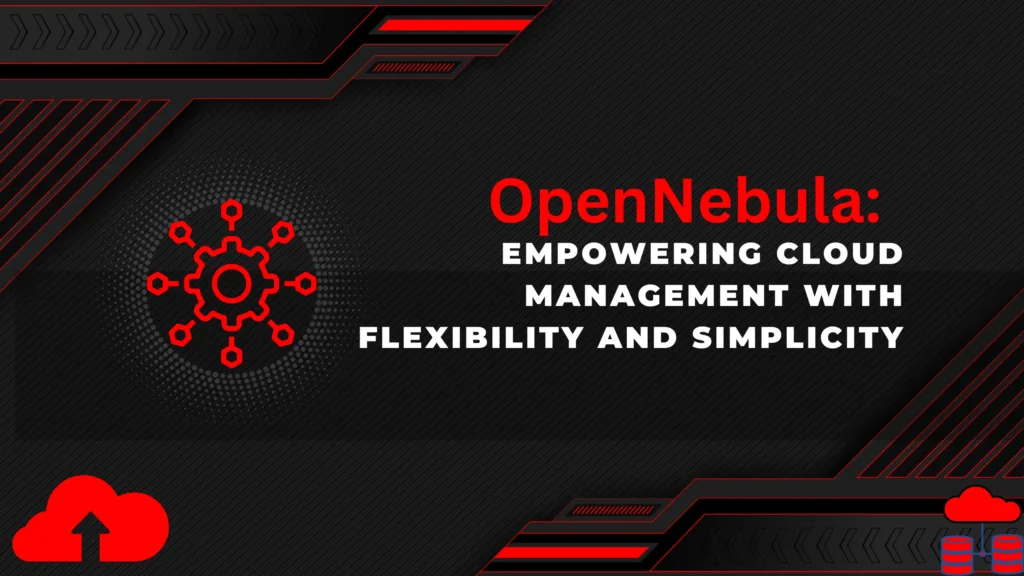Introduction
Organizations increasingly rely on cloud computing to meet their diverse IT needs in today’s digital landscape. OpenNebula emerges as a powerful open-source cloud management platform, providing efficient and flexible solutions to deploy and manage virtualized data centers and private clouds. With its array of features, architecture, and community support, OpenNebula is transforming the way businesses harness the potential of cloud computing.
What is OpenNebula?
OpenNebula is an open-source cloud management platform enabling centralized management of virtualized infrastructures. It allows organizations to easily build and manage private, public, and hybrid clouds. OpenNebula provides a comprehensive set of tools and features for efficiently provisioning, monitoring, and orchestrating virtualized resources, making it an ideal solution for businesses seeking agility and scalability.
Features of OpenNebula
OpenNebula offers a wide range of features, making it a versatile and powerful cloud management platform. Some key features include:
- Multi-tenancy: OpenNebula allows the creation of isolated environments to cater to multiple users or organizations, ensuring secure resource allocation.
- High Availability: OpenNebula ensures the continuous availability of applications and services by enabling redundancy and failover mechanisms.
- Virtual Networking: It provides advanced networking capabilities, including virtual LANs, firewall configurations, and NAT rules, allowing seamless connectivity within the cloud infrastructure.
- Image and Template Management: OpenNebula simplifies creating and managing virtual machine images and templates, enabling easy deployment and scalability.
- Monitoring and Accounting: It offers comprehensive monitoring and accounting tools to track resource usage, enabling efficient resource allocation and cost optimization.
OpenNebula Architecture
The architecture of OpenNebula is designed to provide a robust and scalable cloud management solution. It consists of several key components, each playing a crucial role in the overall functioning of the platform. These components include:
- OpenNebula Core: The core component handles the overall management and orchestration of virtual resources, including VM lifecycle management, scheduling, and monitoring.
- Sunstone: Sunstone is the OpenNebula graphical user interface (GUI), providing a user-friendly web interface for managing the cloud infrastructure.
- Drivers: OpenNebula utilizes drivers to communicate and interact with different virtualization technologies and storage systems, such as KVM, VMware, and Ceph.
- Hooks: Hooks enable the execution of custom scripts or actions at various stages of the VM lifecycle, allowing users to extend the functionality of OpenNebula.
OpenNebula Components
OpenNebula comprises various components that contribute to its comprehensive cloud management capabilities. These components include:
- Virtualization Hosts: The physical servers that host the virtual machines (VMs) and provide the necessary computing resources.
- Virtual Networks: Virtual networks enable connectivity between VMs and the outside world, facilitating communication and data transfer.
- Storage: OpenNebula supports different storage technologies, including local, distributed, and shared file systems, allowing flexible and scalable storage options.
- Marketplace: The OpenNebula Marketplace is a repository of pre-configured VM templates, enabling users to deploy applications and services quickly.
Benefits of OpenNebula
OpenNebula offers numerous benefits to organizations implementing cloud computing solutions. Some key benefits include:
- Flexibility: OpenNebula provides flexibility in managing different virtualization technologies and storage systems, allowing organizations to choose the most suitable options for their infrastructure.
- Scalability: With OpenNebula, businesses can easily scale their cloud infrastructure by adding or removing resources as needed, ensuring optimal resource utilization.
- Cost Efficiency: OpenNebula’s monitoring and accounting features enable businesses to optimize resource allocation, reducing unnecessary costs and improving overall efficiency.
- Simplicity: The user-friendly interface and intuitive management tools of OpenNebula simplify cloud infrastructure deployment and management, reducing user complexity.
Use Cases of OpenNebula
OpenNebula finds applications in various scenarios and industries, catering to various use cases. Some everyday use cases include:
- Private Clouds: Organizations can leverage OpenNebula to create and manage private clouds, giving them full control over their infrastructure and data.
- Hybrid Clouds: OpenNebula facilitates the integration of public cloud services with private infrastructure, offering a hybrid cloud environment that combines both benefits.
- Edge Computing: OpenNebula’s lightweight and scalable nature makes it suitable for edge computing deployments, where resources must be managed in remote or distributed locations.
- Academic and Research Institutions: OpenNebula is widely used in academic and research institutions for managing virtualized environments, facilitating collaboration, and resource sharing.
How to Install OpenNebula
Installing OpenNebula involves several steps to ensure a smooth setup process. Here is a general overview of the installation process:
- Preparation: Prepare the host system by ensuring it meets the minimum requirements and installing any necessary dependencies.
- Installation: Download the OpenNebula software package and follow the installation instructions provided by the official documentation.
- Configuration: Configure the OpenNebula components, including network settings, storage options, and authentication mechanisms, according to the specific requirements.
- Testing and Verification: Validate the installation by creating virtual machines, verifying network connectivity, and testing various functionalities.
OpenNebula vs. Other Solutions
When considering cloud management platforms, comparing OpenNebula with other popular solutions is essential. Here are some differentiators that set OpenNebula apart:
- Open-Source Nature: OpenNebula’s open-source model allows users to access and modify the source code, offering flexibility and customization options.
- Simplicity: OpenNebula focuses on simplicity and ease of use, making it accessible to users with varying levels of technical expertise.
- Flexibility and Extensibility: OpenNebula supports multiple virtualization technologies, storage systems, and networking options, providing organizations with flexibility and extensibility.
- Community and Support: OpenNebula has a vibrant community that actively contributes to its development, ensuring continuous improvements, updates, and support.
OpenNebula and Cloud Computing
OpenNebula aligns perfectly with the principles and advantages of cloud computing. By leveraging OpenNebula’s capabilities, organizations can unlock the full potential of cloud computing, including:
- Scalability: OpenNebula allows businesses to scale their infrastructure up or down quickly, based on demand, ensuring optimal resource utilization.
- On-Demand Self-Service: OpenNebula empowers users to independently provision and manage virtual resources, reducing administrative overhead.
- Elasticity: OpenNebula enables automatic resource allocation and de-allocation based on predefined policies, ensuring efficient resource usage.
- Resource Pooling: OpenNebula pools physical and virtual resources, creating a shared infrastructure that can be dynamically allocated to different users and applications.
OpenNebula Security
Security is a critical aspect of any cloud infrastructure. OpenNebula incorporates various security measures to ensure the protection of resources and data. Some key security features include:
- Authentication and Authorization: OpenNebula supports different authentication methods and provides role-based access control (RBAC) mechanisms, allowing granular control over user permissions.
- Network Isolation: OpenNebula enables the creation of isolated virtual networks, preventing unauthorized access and ensuring secure communication.
- Encryption: OpenNebula supports encryption mechanisms for data at rest and data in transit, safeguarding sensitive information from unauthorized access.
OpenNebula Community
The OpenNebula community plays a vital role in the platform’s development, support, and growth. It comprises diverse users, developers, and enthusiasts who actively contribute to the project. The community offers various resources, including forums, documentation, and regular events, fostering collaboration and knowledge-sharing.
Conclusion
OpenNebula emerges as a robust and flexible open-source cloud management platform, empowering organizations to easily build and manage virtualized infrastructures. Its extensive features, scalable architecture, and active community support make it an ideal choice for businesses seeking efficient cloud solutions. By adopting OpenNebula, organizations can harness the power of cloud computing, drive innovation, and achieve their digital transformation goals.
FAQs
Q: Can OpenNebula be used with multiple hypervisors?
Yes, OpenNebula supports multiple hypervisors, including KVM, VMware, and Xen, providing flexibility in virtualization technologies.
Q: What is the difference between OpenNebula and OpenStack?
While both are open-source cloud management platforms, OpenNebula focuses on simplicity and ease of use, while OpenStack offers a more comprehensive set of services.
Q: Can I use OpenNebula to manage public clouds?
Yes, OpenNebula supports the management of public clouds, allowing organizations to integrate and manage resources from different providers.
Q: Is OpenNebula suitable for small businesses?
Yes, OpenNebula’s scalability and flexibility suit businesses of all sizes, including small and medium-sized enterprises.
Q: How active is the OpenNebula community?
The OpenNebula community is highly active, with regular updates, contributions, and support available through forums, mailing lists, and events.



